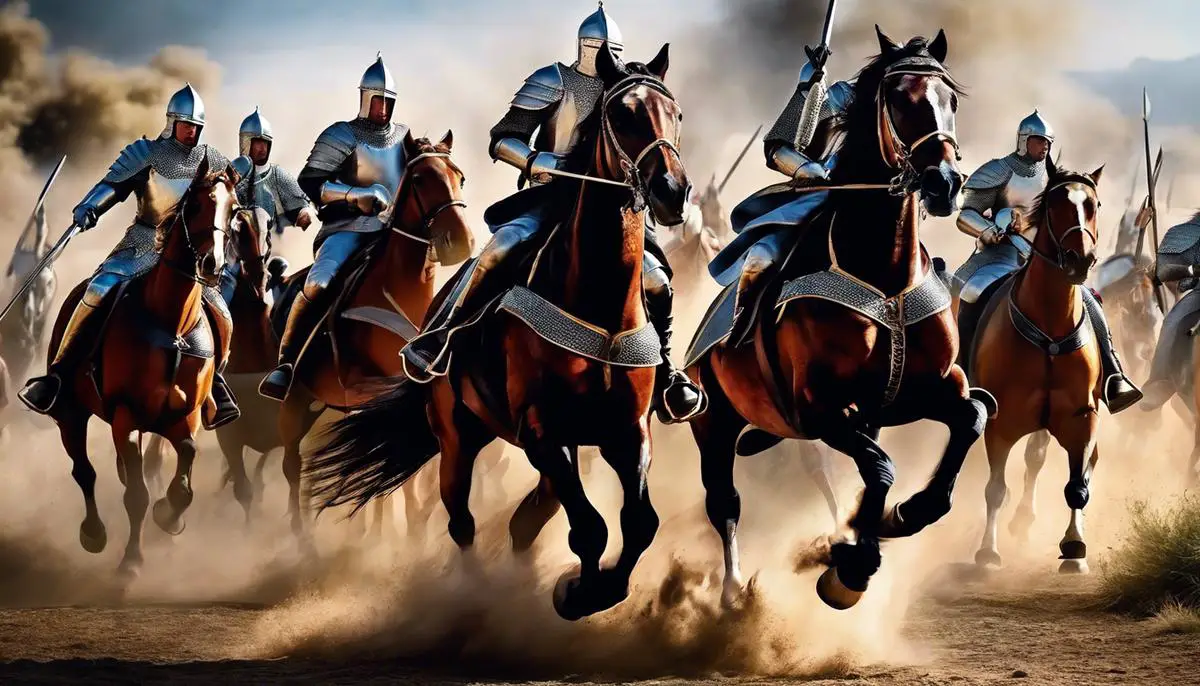Throughout the annals of history, the thundering hooves and valiant hearts of French war horses have galvanized warriors into battle, shaping the outcomes of epic confrontations and altering the course of nations. These equine companions, revered for their strength, endurance, and agility, were not just beasts of burden but critical chess pieces in the grand strategy of warfare. From the chivalrous knights of the medieval era to the elegant cavalry of the Renaissance, the French war horse has been a symbol of military prowess, embodying the soul of an army and the pride of a nation. Embarking on a journey through time, we’ll explore the rich tapestry of these noble creatures’ contributions to historical battles, the evolution of their breeds and the intricate dance of partnership they crafted with the armored warriors who rode them into legend.
Table of Contents (Horspedia)
History of French War Horses
The Mighty French War Horse: A Battle Game-Changer
Have you ever wondered how those grand battles depicted in history books were won? It wasn’t just the strategies or the armor that secured victories; it was also the powerful steeds that carried knights and soldiers to glory. Among the equine champions, the French war horse has an exceptional story that reveals its profound impact on historical battles.
The French war horse, often called the Destrier, was the medieval version of a tank. These horses were renowned for their strength, courage, and speed—qualities that made them a war-time favorite. They stood out from the usual riding horses of the time because they were heavily built, able to carry a knight clad in full armor. Imagine carrying around somebody wearing an entire metal suit while galloping full speed ahead—that was the Destrier’s daily workout!
Their influence on battles was immense. Because of their size and power, they were a force to be reckoned with when charging against the enemy lines. When a cavalry of knights atop these formidable beasts came thundering across the battlefield, they could break the morale of the opposing force. And if you know anything about battles, you know that morale can win or lose wars.
Another aspect where the French war horses shaped history was through the shock tactic called ‘the charge’. When knights lined up and charged the enemy in unison, the earth practically trembled beneath the Destriers’ hooves. This could scatter foot soldiers and even rival cavalries, leading to a swift and decisive victory.
It’s important to remember that these horses weren’t just brutes; they were also highly trained. They knew complex maneuvers and were responsive to subtle commands. Knights and their horses trained together to become an unbeatable team. And let’s just say, they had quite the winning streak, helping France dominate the battlefields of medieval Europe.
Whether it was the Hundred Years’ War or other famous conflicts, the French war horse helped to clinch victories and etch them into history. These majestic animals were no commonplace horses; they were the MVPs of their time, giving knights a leg-up in their quest for glory.
So there you have it—when it came down to a battle that looked like it could go either way, the French war horse often tipped the scales. They may not be around today charging down fields, but their legacy gallops on in history, ensuring we never forget the role these creatures played in shaping the world as it is today.
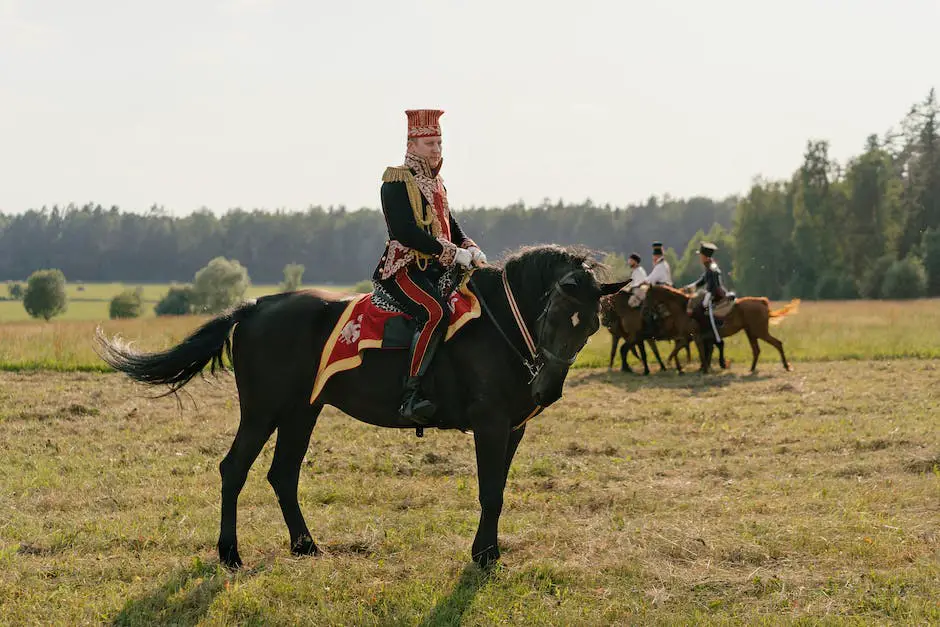
Breeds and Characteristics
What Distinguishes French War Horse Breeds from Others?
Ah, the mighty and majestic war horses of France! These awe-inspiring animals are more than just a part of history; they are a symbol of strength and strategy that helped shape Europe as we know it. But what makes French war horse breeds stand out from their equine counterparts across the world?
First off, it’s the breeding. French war horses were carefully bred for power and endurance. They had to carry heavily armored knights into battle, which was no easy feat. That’s why these horses were larger and sturdier than most – they were the ultimate beast of burden on the battlefield. Think of them like the tanks of the Middle Ages, except with hooves and a mane.
Now, let’s talk about their temperament. While you might think a war horse would be all fire and fury, that’s not quite the case. French war horses were known for their calmness under pressure. This was super important because the chaos of battle would be enough to spook any animal! These horses needed to keep their cool, so their riders could focus on the fight.
Another standout feature was their agility. Despite their size and strength, French war horses could move with surprising speed and grace. Dodge, weave, dash into battle – these horses could do it all while carrying a knight in full armor. It’s like they were the heavyweight champions of a medieval dance-off, only much more serious and with higher stakes.
Plus, they had endurance in spades. French war horses could sustain a long day of fighting, with the toughness to match. They didn’t tire easily, which was critical in lengthy battles where stamina could mean the difference between victory and defeat.
Lastly, these horses had something no less important: heart. The trust and bond between horse and rider were crucial, as they went through rigorous training together, forming an unbreakable team. The horse’s willingness to charge into danger for their rider is legendary; it’s the kind of brave loyalty that epic tales are made of.
In the end, what distinguished French war horses wasn’t just their size or strength. It was the combination of physical prowess, a steady mind, agility, endurance, and courageous spirit. Together, these traits made them a formidable force in warfare, and it’s no wonder their legacy lives on in the pages of history. These noble steeds were more than animals; they were true warriors in their own right.
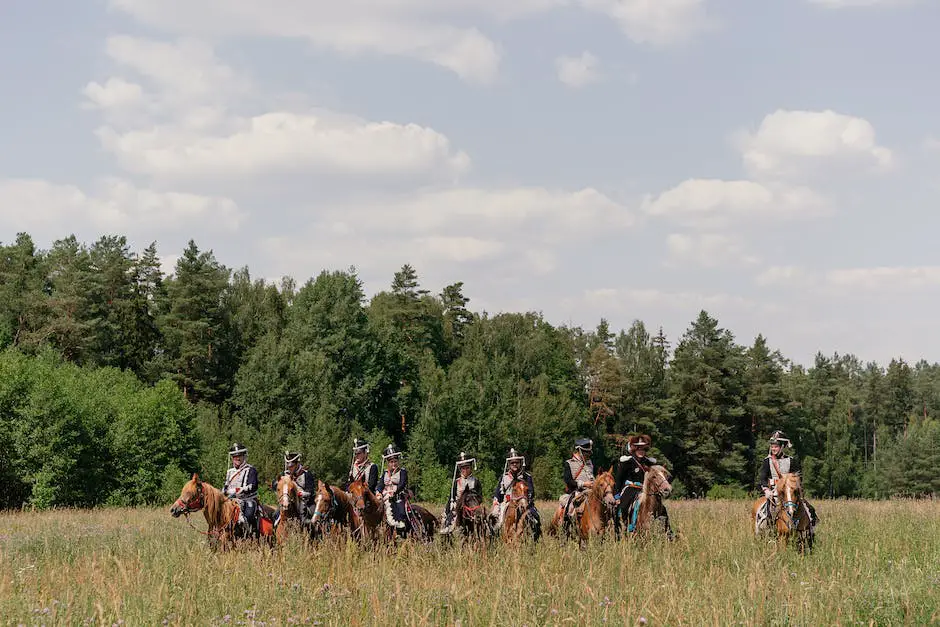
Armaments and Tack
Armament and Tack Fit for a Knight: The Gear of French War Horses
Stepping into the world of medieval cavalry, it’s often the knight that captures the imagination with their shining armor and heroic deeds. Yet, it’s the knight’s trusted steed that deserves equal, if not more, accolades. The French war horse, famed for its prowess on the battlefield, was not only the mount of a knight but a crucial part of the military machine. The question then is, how was such a mighty beast geared up for battle? Let’s dig into the armaments and tack that transformed the French war horse into a living fortress.
First up, armor; or as fancy folks like to call it, barding. Barding was essentially the knight’s armor but designed for horses. The aim was to protect these noble creatures’ vital areas while allowing for mobility. This gear wasn’t just run-of-the-mill iron slapped on. No, it was meticulously crafted from metals like steel and sometimes adorned with gold or silver for those of high rank. It typically covered the head, chest, flanks, and sometimes the hindquarters.
The ‘chanfron’ was the metallic mask safeguarding the horse’s face, often crafted to look fierce with decorative elements that could intimidate opponents. Let’s not forget the ‘crinet’, made of segmented plates to protect the neck without sacrificing flexibility. Then, there was the ‘peytral’, shielding the chest, and the ‘crupper’ covering the hind. Some of these war horses even wore ‘flanchards’ to defend their sides during sideway engagements.
Next, the tack, which includes all the necessary equipment for riding. A sturdy saddle was essential, equipped with high backs and fronts for the rider’s security. These were nothing like the lightweight saddles today! They were built to support the weight of an armored knight and withstand the jostles of combat, usually reinforced with metal. Girths and stirrups were fortified to match, ensuring the rider stayed put even when the charge got rough.
Let’s not skip the impressive ‘destrier harness’. This was a heavy-duty collection of straps and belts that kept the barding in place and allowed the horse to carry such an armored load without slipping. Add in a strong bridle and bit for precise control, and you’ve got the complete package that led these horses and their riders into many a clash.
Of course, all this metal came with a catch; it was heavy. War horses had to be powerhouses to bear the weight. Each piece of armor was custom-made to fit the individual horse, assuring they could still move with speed and necessary freedom. This gear wasn’t just dropped on a horse the day before battle; war horses trained with it, building the strength and comfort needed to operate as effective units with their riders.
The French went to great lengths to protect and empower their war horses, like a medieval version of customizing a car for peak performance. The synthesis of impenetrable defense with awe-inspiring offense created a legendary image of the French war horse, a beast of war, fully decked in protective gear, charging fearlessly toward victory.
In the ebb and flow of war, French war horses donned their battle garments with pride, standing as testaments to human ingenuity and animal bravery. The might of these horses, adorned in the finest armaments and tack, endures in the annals of history, a story of ironclad titans that could shake the very ground they thundered upon.

Role in Culture and Society
From Tapestries to Triumphs: The French War Horse in Art and Society
When one thinks of the French war horse, images of chivalry, grand battles, and valiant knights often come to mind. However, the role of these magnificent beasts was not confined to the battlegrounds. They also galloped into the hearts of artists and the public, becoming celebrated icons in both art and society.
Imagine walking through the halls of a grand French chateau and coming across an imposing tapestry. Threaded within its fabric were scenes of these noble animals, their graceful forms reflecting strength and heroism. Artists of the time sought to capture the essence of their power and their pivotal role in warfare, often glorifying them just as much as the riders they bore.
Statues and paintings from the era further immortalize the French war horse, presenting them in mid-battle action or standing proudly alongside their noble owners. Such works served not only as decoration but also as symbols of prestige and pride for their owners. The horses depicted in these pieces of art were usually the destriers, the elite of the war horses, showcasing their muscular build and often adorned with intricate armor that attested to their importance.
Public festivities and tournaments were other avenues where these horses shone. Jousting, a sport that tested the skill of knights, provided a platform for the French war horses to display their training and finesse. Crowds would marvel at the sight of these animals charging bravely towards their opponents, their riders’ lances aimed and ready. In these competitions, the war horse was as much a competitor as the knight, and their performance could sway the favor of the audience.
In literature, the French war horse galloped through pages of tales and legends. They were the loyal companions of heroes, their gallantry enhancing the aura of the knights they served. The celebrated King Arthur’s steed and the loyal mounts of the Knights of the Round Table are examples where the war horse’s valor was enshrined in story and song.
Even as the role of the horse in warfare waned with the advancement of technology and military strategy, the French war horse remained a symbol of a bygone era. Their spirited representations in arts and public imagination remind us of a time when the thunder of hooves and the bond between rider and steed could turn the tides of battles and empires.
So, while these majestic animals no longer stride the battlefields as they once did, their legacy in art and society endures, capturing the admiration of those who appreciate the beauty and nobility of the French war horse.
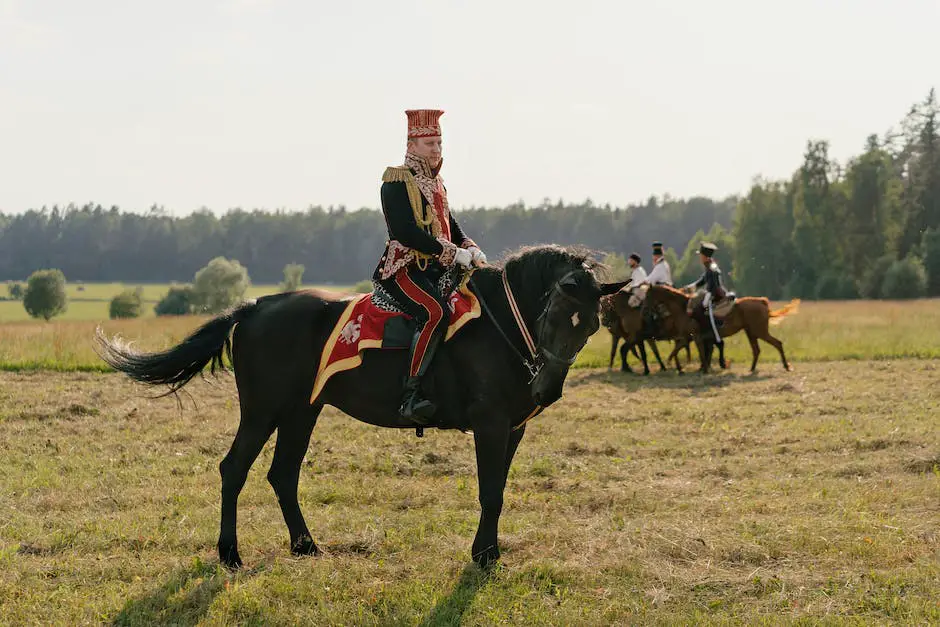
Preservation and Legacy
Preserving the Legacy of the Magnificent French War Horse
In the realm of equine history, the French war horse’s story is one that echoes the tumult and triumphs of medieval Europe. These noble steeds have galloped through the pages of history, but they face new battles in the modern era – that of preservation and remembrance.
As the role of horses in warfare diminished, so did the centrality of breeding and maintaining these storied creatures. Yet, enthusiasts committed to safeguarding this rich heritage have rolled up their sleeves and are involved in various initiatives to ensure that the legacy of French war horses is not lost to time.
Conservation breeding programs are one of the primary ways through which the lineage of French war horses continues today. These programs carefully monitor bloodlines and strive to maintain the genetic diversity that is so crucial for the health and vitality of the breeds. Museums and historical societies have also taken up the mantle, offering educational programs and interactive exhibits where the public can learn about the war horse’s role in European history.
Moreover, restorations of significant artifacts, such as armor and equipment specifically crafted for these horses, are becoming more common. Museums and private collectors alike recognize the value of preserving these items, not just as relics of a bygone era, but as educational tools that offer a tangible connection to the past.
Living history events and reenactments play an instrumental role in keeping the war horse’s legacy alive. These events provide a dynamic platform for enthusiasts to experience the power and beauty of these creatures in action, just as they would have appeared on the battlefields of the past.
Additionally, the French war horse is commemorated in local festivals and traditions. Some towns hold annual events that celebrate their historical connections to these magnificent animals, complete with parades and shows featuring modern-day descendants of the war horse breeds.
On a grass-roots level, riding clubs and historical associations often adopt the symbols and stories of the French war horse, incorporating them into their identities and activities. This not only raises awareness but also fosters a community of individuals who share a passion for these horses and their remarkable stories.
In literature and academia, comprehensive studies and books dedicated to the French war horse serve as repositories of knowledge, ensuring that enthusiasts and scholars have access to information about these animals and their critical role in shaping human history.
Virtual platforms and online communities have also emerged as a vital resource for sharing data, insights, and enthusiasm about the French war horses. Social media groups, blogs, and forums allow people from all corners of the globe to exchange stories, photos, and research, further solidifying the war horse’s place in our collective consciousness.
Through these concerted efforts, the grandeur and grit of the French war horse shall not be forgotten. It is through the toil and love of enthusiasts and historians that the thunderous hoofbeats of these legendary steeds will continue to resonate through time, long after the last charge into battle.
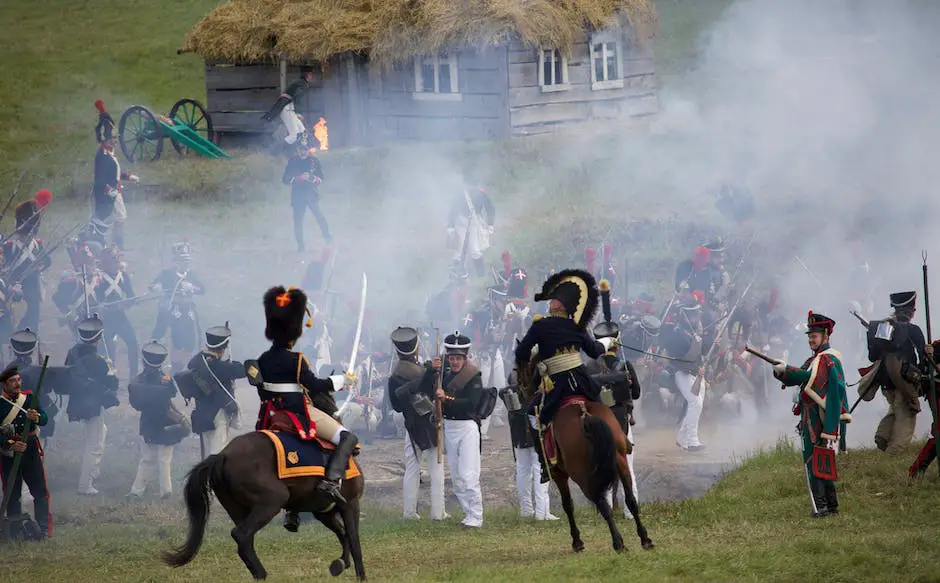
As the dust settles over historic battlegrounds and the echoes of clashing swords fade, the legacy of the French war horse remains indelibly etched in the annals of time. These gallant steeds, once the pride of emperors and the envy of the battlefield, now graze in the quieter pastures of memory and preservation. Their hoofbeats resonate through the generations, inspiring modern horse enthusiasts and reminding us of an age when the bond between rider and horse was the currency of power. As we gallop forward into the future, it is our responsibility to honor and safeguard this hallowed lineage, ensuring that the tales of valor and the spirit of these magnificent war horses are never forgotten.
